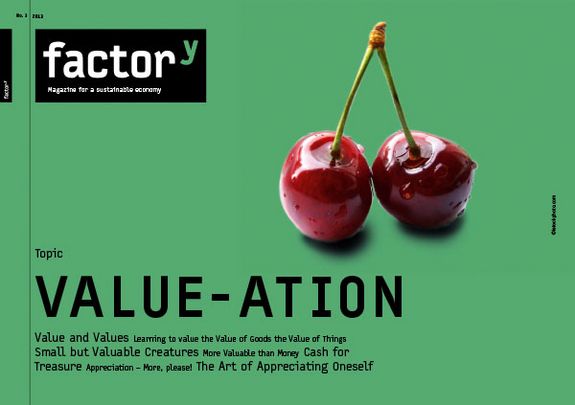Value-ation

The assessment of value that predominates today is an economic one: the price determines the value. However, the actual meaning of a value lies in its use, in its quality. A shift from valuation to appreciation could change our view of things.
By Joachim Spangenberg
(Translated from the German by Jan Maintz, Dorothée Schmidt, Lara Nettekoven and Susanne Mollen)
In terms of linguistic history, 'worth' refers to things we value, things that are important to us. If we look it up in a dictionary, the term 'worth' in its etymology has a positive meaning. It has something of momentousness, a special quality. Nowadays, when talking about the worth of something, we generally refer to its price. What is interesting about this change in value is its history and how it is to be assessed.
When we talk about value in the singular, we are referring to a quantifiable and thus addable value which can be used to compare different goods and people; this means a value independent from subjective valuation and hence, objective.
This is what monetary value offers: by definition, prices are determined by the market, do not depend on people and help to make the value of goods comparable. We (sometimes) exchange things of the same monetary value directly for one another, or (in most cases) indirectly using money, that is through a monetary system. The classic economists (Smith, Marx, Ricardo) called this 'exchange value'.
However, they also knew use value. Use value refers to how important something is for its user or owner, meaning a subjective appreciation. Therefore, a market process always results from the use value of a good being smaller for its owner than its exchange value (i.e. the imaginary use value of another good is acquired with the proceeds): then we sell. In the end, everyone possesses – proportionately to his own purchasing power – the goods he values the most. On the other hand, if the value estimation is very high from the beginning, there may not be anyone who offers enough for a transaction to take; supply does not meet demand, so there is no exchange value. If the owners consider the goods to be absolutely essential and are in no way ready to sell, then there is a priori no exchange and thus no exchange value (price). The absence of price does not necessarily mean that something is worthless –on the contrary, it can be so valuable that a sale is not even considered and consequently it does not have any market price.
Price does not determine value
Even today, no reasonable (even neoclassic) economist will deny that there are other values than those expressed with money. There is the intrinsic value of sensible beings, which applies independently of every use and has no price, or (what is less generally recognised) the inherent value of objects that are unique and irreplaceable: the Mona Lisa has an inherent value independent of any price, which cannot be expressed monetarily; an endangered bird species is valuable, but it has no market price. According to Kant, such objects have no price due to their irreplaceability, but they have dignity. In contrast to this, prices value different but interchangeable goods with respect to their instrumental values. Nevertheless, in the area of economics – and more and more in politics and society as well – the monetary value becomes the dominant, if not the only value to be taken into consideration. An example for this economization of thought is the increasing valuation of nature, ecosystems and their productivity in monetary units. From the point of view of value theory, this represents an error of category: inherent values (‘dignity’) are mistaken for instrumental values – only the latter have monetary value.
The oft-used argument, that a – questionable – monetary value is always better than a price of ‘zero’, illustrates this well. It means that the non-existence of a price equals the existence of a price of ‘zero’ and demands a different price instead of other decisive criteria, not solely based on monetary values (i.e. in cost-benefit analyses). Where does this restricted view come from? The earliest economists, the physiocrats of the 18th century, reacted to the crisis of the agrarian society in Louis XIV's time; they described the soil (today we say: the environment) as the source of wealth. In the early years of the industrial society in the 19th century, with its mass production and huge volume of labour, it was generally indisputable that human work was the source of all economic values, even when Smith, Marx or Malthus mentioned the necessary contributions of nature and environment. At the founders’ time, neoclassicism, which basically describes the economy as an exchange system, dominated – trade increased and globalization was stronger in 1900 than it is 100 years later. An intrinsic value of things was not of interest anymore. What counted was the exchange value or trading price. Work and (increasingly more importantly) capital were the production factors that created value.
Crisis of value and value of crisis
The global economic crisis interrupted the hegemony of neoclassicism in the field of economics; from the 1930's to the late 1970's, Keynesianism dominated. It did not focus on the micro-level of exchange, but rather on the regulation of the complex system of the national economy. After the failure of a common political Keynesianism during the crisis of the 1970's, the supply-oriented perspective of neoclassicism, fixed on the micro-level of exchange, gained the upper hand once 'again. Free trade became a dogma; markets could not be disturbed (i.e. through political intervention or collective agreement), so that they could shape the ‘objective real’ prices, depict the consumers' values (their preferences), produce ideal solutions and maximize welfare. The dominance of the finance sector, which has developed in the course of globalization, only changed a little about the worldview. The ‘market laws’ were transferred to the financial markets and deregulated them (although Adam Smith had already excluded the finance sector from his deregulation).
The worldview remained simple and monetary; the economy was understood as exchange and money circulation: companies pay salaries in exchange for labour, then consumers buy products in exchange for money, the use value plays no role. Resources simply exist, rubbish disappears unseen (which corresponded to the state of the rubbish economy until the 1960s). When nature makes itself noticeable and does not behave according to these assumptions, when the procurement and disposal of material becomes an essential cost factor (in the manufacturing industry, on average a company spends double the amount on material compared to that spent on wages or salaries, but spends only about two percent on energy), the day of environmental and resource economists will have come.
Cost-relevant environmental aspects were integrated into the money-oriented worldview. Resources have a price and nature has a monetary value (insofar as nature is relevant as a factor of production). Environmental burdens indicate a market failure. Since the polluter does not have to pay for the burdens, the market does not – as is legitimate at other times – deliver an ideal result. The solution is clear: The externalised costs that are not covered by the polluter have to be internalised and therefore have to be charged to the polluter’s account; this is the ‘polluter pays' principle. Then ‘prices tell the ecological truth’ and the market functions ideally again. For that, it is not necessary that the compensatory payments benefit the victims. However, this theory – connected to names like Pigou and Coarse – is designed to correct the slight failure to meet certain targets. Ecological and social burdens, however, as Karl William Kapp already demonstrated in the 1950s, are not an avoidable side effect, but rather a functional principle of our market economies. Externalising does not equal market failure, but rather business success.
The value of determining value
Behind the evaluation of the environment as a monetary value is the belief in the market and its ability to offer ideal solutions – that is why the environment has to have a market price, meaning an exchange value, and for that purpose has to become a trade commodity (this is called commodification). In doing so, it is erroneously assumed that the economic optimum does not have to be socially or ecologically optimal, and indeed cannot be optimal, because it disregards all of the values that cannot be expressed in prices. As a result, the extinction of a certain species can be the economically optimal option under certain circumstances – it only has to be worth it and the species cannot have a market value that is too high. Instead of relying on the market to find solutions, it would be necessary to take the information provided by the market as one factor among others that can, but does not have to, play a role in decision-making. Moreover, the factor’s significance is to be evaluated in social and political judgement. Markets are institutions for the distribution of goods, the coordination of purchase decisions and for the collection of information, but they are neither legitimate nor optimal bodies of decision-making. The lesson is clear: we should neither overrate the function of markets and the significance of prices, nor should we underrate them. Furthermore, when making decisions, we should consider the significance of intrinsic and inherent values (the ‘dignity’ of goods) that cannot be measured in money. Still, trying to do so is a form of ‘sub-optimisation’. It is an attempt to make something as good as possible, which should not be done. Commodification is based on an error in reasoning. Its result is a weak foundation built on sand at best and a disaster for humans and the environment at worst.
Dr. Joachim Spangenberg is a biologist, ecologist and economist. He works at the Helmholtz Centre for Environmental Research UFZ and for the Sustainable Europe Research Institute SERI in Germany on criteria, indicators and scenarios for a socioeconomic development that respects ecological boundaries and secures the preservation of the ecosystem service.
More on values, its estimation and appreciation here in topics and more beautiful and detailed in the factory-magazine Value-ation. The free available PDF-magazine contains additional citations and numbers, is finely designed and well readable on tablets and screens.
Beiträge online
VALUE-ATION

- Worth and Values
- Learning to value the value of goods
- Worth more than money
- Appreciation – more please!
- Bares für Wertvolles
- Die Kunst, sich selbst zu schätzen
Themen
- The Domino Effect: the Mobility Transition as an Engine for the ‘Great Transformation’
- Cities Use the Space
- Decarbonization by 2030
- The fear of biting the hand that feeds you
- Where investing is a pleasure
- Why divestment is going to change the world
- A Robin Hood tax for climate protection
- May the Force Be with Us
- Modern Strategies
- The prerogative of interpreting the future now lies with the companies involved in climate protection”
- From Negotiating to Trading Equitably
- Can a donkey be tragic?
- Rethink rather than rebound: a sufficiency revolution must precede the efficiency revolution
- On Rebound, Prebound and Performance Gaps
- So Let Us Seize Power Then!
- With Common Property Against Political Failure
- So Let Us Seize Power Then!
- The Comforting Beauty of Failure
- “It Is Not Impossible at All.“
- Resource-light shopping
- Men Have Not Stopped Giving the Advantage to Women – So Far
- Toothpaste for Princesses and Soup for Pirates
- It is about equality
- A nice day
- Initiative instead of frustration
- The right ingredients
- Resilient for Life
- Not only, but also
- Appreciation – more please!
- Worth more than money
- Learning to value the value of goods
- Worth and Values
- The Transformative Power of Science
- Historically effective: How innovation and technology transform
- The Disappearance of Products
- Growing Older 101
- Columbus’ Egg
- It Works! In Theory at Least ...
- What If...?
- Analysing Separately – Thinking and Acting Together!
- Let’s Break Away from Determined Breaking Points
- More Gold in Waste than in Mines
- The art of separation
- Should you really DIY?
- The Aesthetics of Do-It-Yourself
- Standing on One’s Own Feet
- From the handaxe to desktop fabrication
- Using Shares to Survive the Crisis
- When Citizens participate
- Possess to Participate
- The Right Growth at the Right Time
- Gunter Pauli and Blue Economy
- When Sustainability Grows
- How we treat Growth
- Illusions about Growth

